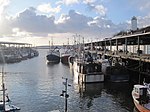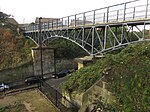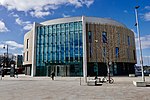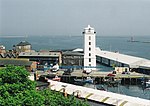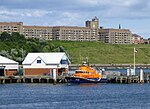North Shields Fish Quay is a fishing port located close to the mouth of the River Tyne, in North Shields, Tyne and Wear, North East England, 8 miles (13 km) east of the city of Newcastle upon Tyne.
The quay began life in 1225 as a simple village of shielings (seasonal huts used by hunters or fishermen) around the Pow Burn (stream or river); the town of North Shields takes its name from the shielings. The quay was originally located here to serve the nearby Tynemouth Castle and Priory. The original site is largely derelict industrial land currently being redeveloped, which lately belonged to the original Tyne Brand canning company. The Pow Burn runs from nearby Northumberland Park and disappears underground at Tynemouth Road and the Metro urban transport line, eventually flowing into the Tyne.
The growth of North Shields was at one time restricted due to fear that it would take trade from neighbouring Newcastle upon Tyne, which was the region's leading port at the time; its trade guilds resented trade outside of the city, so much so that coal mined in North Shields within 300 ft of the river had to be transported on land 8 miles to Newcastle to be loaded onto boats.The most striking buildings are the now defunct High Light and Low Light lighthouses which, in the 18th and 19th centuries, provided a line of sight for vessels entering a fairly treacherous river mouth. Until the north and south piers were built many ships foundered on the treacherous rocks known as the 'Black Middens', which lie to the east of the quay and can be seen at low tide.
The site actually has an original Old High Light and Old Low Light as well as a slightly differently positioned later High Light and Low Light, so called because they were positioned low (at river level on the quay) and high (on the bank top some 150 ft higher).
The present quay was built in 1870 to accommodate the increase in fishing boats after the introduction of steam trawlers. It is still a working fishing port with a trade fish market; it is the largest English port for prawns. Its proximity to the Dogger Bank has meant that a number of fishing boats from Whitby and elsewhere on the north east coast have relocated there. Adjacent shops include many fresh fish outlets and fish processing, mainly crab and prawn, continues in industrial units.
The Fish Quay was once the biggest kipper producer in the UK, but the fall in herring stocks has reduced the trade to a single smokery. A number of traditional smokehouses still exist but have been converted to other uses, the area having been substantiallyy repurposed to include residential accommodation, eateries and other entertainment facilities. However, although much reduced, a healthy seafood trade still exists with daily refrigerated lorry movements.
Clifford's Fort, located on the Fish Quay, was built in the 17th century (1672) as a coastal defence against the Dutch, and also played a role during the Napoleonic Wars. The fort was named after Lord Clifford, a member of King Charles II's Cabal. It is now a scheduled monument.The Fish Quay declined in the 1980s as a result of problems in the fishing industry. Refurbishment of the area was begun by Tyne and Wear Development Corporation and then beginning in 2001 based on a consultancy report. The Old Low Light building has been converted into a heritage centre, which opened in 2015.



